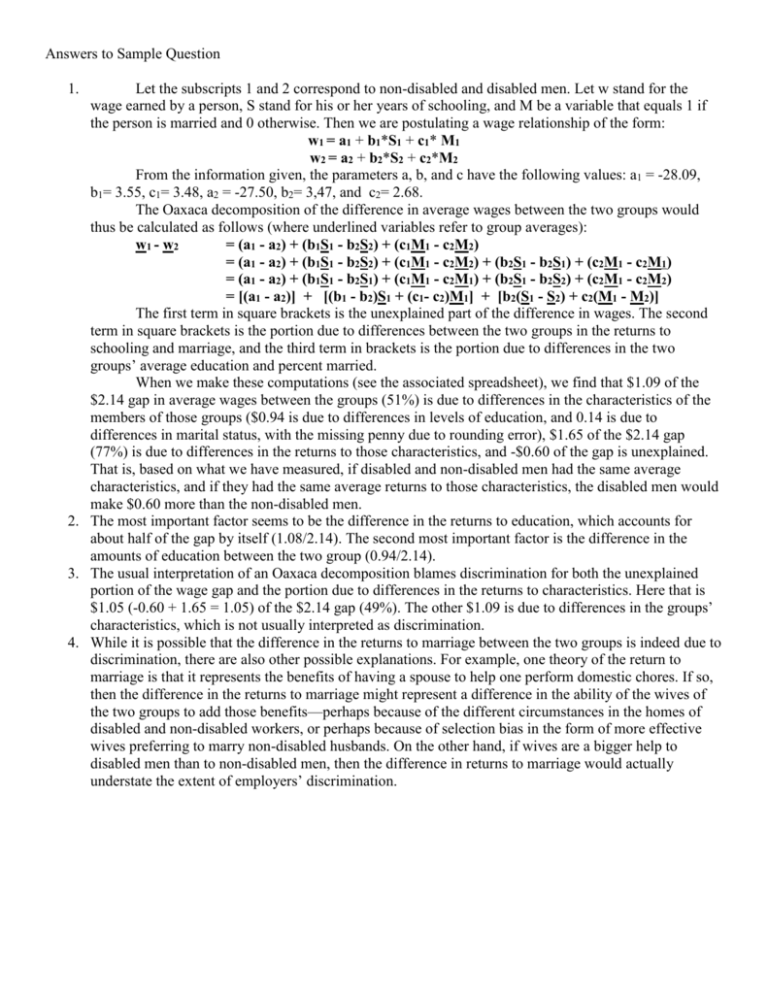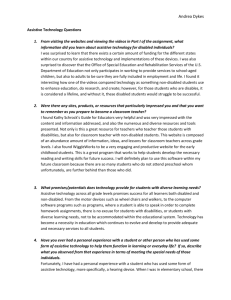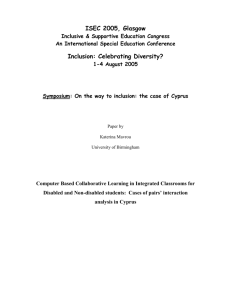AnswerstoSampleQuestionOnOaxacaDecomposition
advertisement

Answers to Sample Question 1. Let the subscripts 1 and 2 correspond to non-disabled and disabled men. Let w stand for the wage earned by a person, S stand for his or her years of schooling, and M be a variable that equals 1 if the person is married and 0 otherwise. Then we are postulating a wage relationship of the form: w1 = a1 + b1*S1 + c1* M1 w2 = a2 + b2*S2 + c2*M2 From the information given, the parameters a, b, and c have the following values: a1 = -28.09, b1= 3.55, c1= 3.48, a2 = -27.50, b2= 3,47, and c2= 2.68. The Oaxaca decomposition of the difference in average wages between the two groups would thus be calculated as follows (where underlined variables refer to group averages): w1 - w2 = (a1 - a2) + (b1S1 - b2S2) + (c1M1 - c2M2) = (a1 - a2) + (b1S1 - b2S2) + (c1M1 - c2M2) + (b2S1 - b2S1) + (c2M1 - c2M1) = (a1 - a2) + (b1S1 - b2S1) + (c1M1 - c2M1) + (b2S1 - b2S2) + (c2M1 - c2M2) = [(a1 - a2)] + [(b1 - b2)S1 + (c1- c2)M1] + [b2(S1 - S2) + c2(M1 - M2)] The first term in square brackets is the unexplained part of the difference in wages. The second term in square brackets is the portion due to differences between the two groups in the returns to schooling and marriage, and the third term in brackets is the portion due to differences in the two groups’ average education and percent married. When we make these computations (see the associated spreadsheet), we find that $1.09 of the $2.14 gap in average wages between the groups (51%) is due to differences in the characteristics of the members of those groups ($0.94 is due to differences in levels of education, and 0.14 is due to differences in marital status, with the missing penny due to rounding error), $1.65 of the $2.14 gap (77%) is due to differences in the returns to those characteristics, and -$0.60 of the gap is unexplained. That is, based on what we have measured, if disabled and non-disabled men had the same average characteristics, and if they had the same average returns to those characteristics, the disabled men would make $0.60 more than the non-disabled men. 2. The most important factor seems to be the difference in the returns to education, which accounts for about half of the gap by itself (1.08/2.14). The second most important factor is the difference in the amounts of education between the two group (0.94/2.14). 3. The usual interpretation of an Oaxaca decomposition blames discrimination for both the unexplained portion of the wage gap and the portion due to differences in the returns to characteristics. Here that is $1.05 (-0.60 + 1.65 = 1.05) of the $2.14 gap (49%). The other $1.09 is due to differences in the groups’ characteristics, which is not usually interpreted as discrimination. 4. While it is possible that the difference in the returns to marriage between the two groups is indeed due to discrimination, there are also other possible explanations. For example, one theory of the return to marriage is that it represents the benefits of having a spouse to help one perform domestic chores. If so, then the difference in the returns to marriage might represent a difference in the ability of the wives of the two groups to add those benefits—perhaps because of the different circumstances in the homes of disabled and non-disabled workers, or perhaps because of selection bias in the form of more effective wives preferring to marry non-disabled husbands. On the other hand, if wives are a bigger help to disabled men than to non-disabled men, then the difference in returns to marriage would actually understate the extent of employers’ discrimination.






